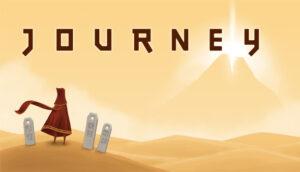
For this critical play, I had the pleasure of playing Journey on IOS! Journey is an indie adventure game developed by Thatgamecompany and published by Sony. It’s original platform was the Playstation, but has since become available on IOS, Android, and Windows. Walking is one of the few mechanics in Journey, but facilitates a slow and meditative discovery of the worldscape. Players are guided by visual cues such as beacons of light and moving flags, and the omnipresence of the runes adds to a sense of curiosity and mystery that drives the game forwards.
Having never played a walking game before, I honestly expected the game to be boring, but upon starting the game I was immediately blown away by the stunning visuals. The environment itself tells so much of the story – the vastness of the sand dunes and the simplicity of my character offers a sense of solitude. I truly felt like a lone traveler.
At the beginning of the game, players must traverse plain sand dunes and follow peculiar tombstones that lead to abandoned ruins. There are no constraints to which direction players may walk, which adds to the feeling of untethered exploration that the game offers – however, Journey utilizes visual indicators to guide players to explore certain areas of the map. Moving flags were an important indicator as to whether or not I was moving in the right direction as I approached the ruins. Wind is another game element that is cleverly used to guide players in the right direction. When I attempted to climb too far up a hill, the sand rustled and the wind toppled me over back down the dune.

The game was driven by my curiosity about the runes — it was obvious that they were important, but what did they symbolize, and why was I able to activate them? This simple question that the game evokes in the player is what hooks them into the game.

I discovered that upon nearing the floating flags, I was able to automatically collect them and gain the ability to jump/fly. This simple game mechanic added a layer of excitement to the game without complicating it – the design choice to have the flags be automatically collected, instead of giving the player a button to collect them manually, is a deliberate way to limit the number of actions the player is able to make. The game designers purposefully kept the controls simple and few in number: players are able to turn, walk, fly (when flags have been collected), and activate runes. This contrasts to games such as Minecraft, in which the player is also walking forwards and exploring, but has many options to pick up, to pickaxe, to build, all of which are tasks that would distract the player from the primary goal of exploring if incorporated into Journey. The lack of buttons and actions keeps the player focused on the narrative, the landscape, and the feeling of exploration, instead of worrying about smaller tasks. As described by Salon’s article on walking sims, this walking game is truly a departure from traditional task-driven or objective-driven gameplay. The player is given little control over the outcome of the storyline of the game; instead, the player’s objective is to uncover it and take in the beauty along the way.
Additionally, as I attracted the flags, my scarf grew longer and glowed with runes as a visual cue that seemed to symbolize my growth in power and ability. Glowing is another visual cue that Journey uses that seems to symbolize the presence of something magical and unknown. Halfway into playing, I was confused and was getting frustrated at lack of progress until I paused, looked around, and saw a glowing white light atop a mountain – it was a simple way for the game to communicate how to progress forwards to me, the player, without speaking a word.
Music is an important factor that adds to the atmosphere of Journey – in the beginning, upon uncovering a new landscape, the music swelled to be dramatic and passionate. As I dawdled towards the next achievement, the music was slow, steady, yet suspenseful, instilling a sense of urgency in me as I explored my surroundings and collected flags. The music is important in guiding the players to feel certain emotions of triumph or fear as they explore.
Overall, the beautiful visual cues, the simplicity of the game controls, and the symbolism of flags, light, and runes allows Journey to master the aesthetic of discovery, as players uncover new territory and new clues about their surroundings. Another driving aesthetic is sense pleasure – the world is beautifully rendered, and the slow walking pace of the narrator encourages players to take in the art whichever way they choose to turn.



